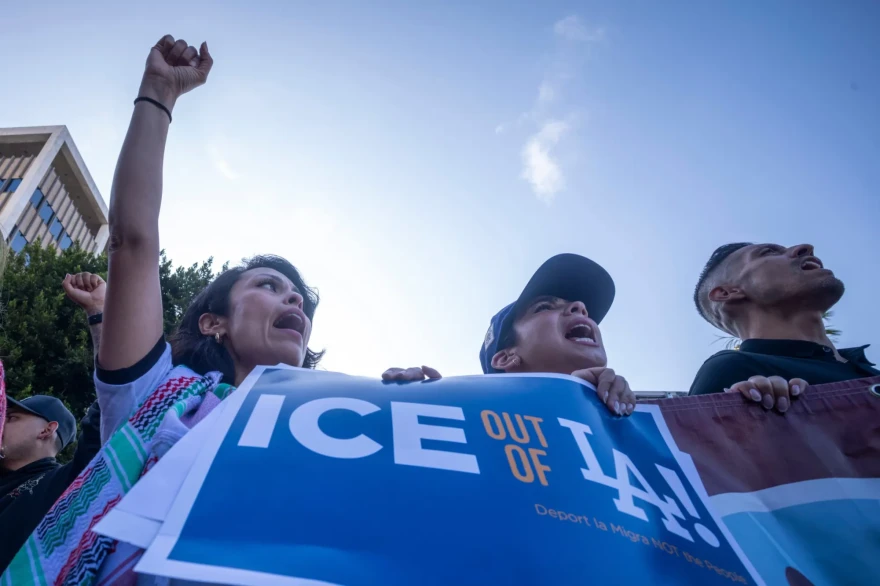This story is free to read because readers choose to support LAist. If you find value in independent local reporting, make a donation to power our newsroom today.
What US citizens and lawful residents should know and carry during ICE raids in LA

This story was originally published by Boyle Heights Beat on July 7, 2025.
As federal immigration authorities continue a wave of arrests in Los Angeles County, even U.S. citizens and lawful residents are expressing fear and concern about being targeted or caught up in enforcement operations.
Immigrant rights advocates and lawyers have reported a surge in racial profiling and excessive use of force, particularly in Latino and immigrant-heavy neighborhoods. Federal law enforcement officials have denied those accusations.
“We’ve been seeing… people who are U.S. citizens or lawful residents getting stopped, getting asked questions, even detained, or arrested,” said Marissa Montes, a professor and director of Loyola Law School’s Immigrant Justice Clinic. “This is something I had suspected was going to happen because of Trump’s rhetoric and because the U.S. has a history of deporting U.S. citizens.”
Montes compared what’s happening today to historic injustices, including the incarceration of people of Japanese ancestry – the majority of them U.S.-born citizens – during World War II, when citizenship status did not protect individuals from being placed in camps. She also said that some U.S. citizens detained during the current raids have reported being pressured to sign documents waiving their right to sue the government for wrongful detention—something Boyle Heights Beat has not independently verified.
Videos and news reports have emerged showing Latino U.S. citizens being stopped and interrogated. Montes underscored that asserting one’s constitutional rights matters, even if the system doesn’t always respect them. “We can’t stop the machine, but we can slow it down,” she said.
Boyle Heights Beat cannot provide legal advice, so we asked Montes to share what people—regardless of immigration status—can do to protect themselves, their families, or their neighbors in moments like these. Here are her tips.
Note: While this guide is focused on U.S. citizens and lawful residents, undocumented individuals face heightened risk. Legal experts advise undocumented persons not to carry foreign ID documents and to assert their right to remain silent. Learn more about your civil rights — regardless of immigration status — and find resources here.
What to carry if you’re a U.S. citizen or lawful resident
U.S. citizens or lawful residents should carry valid proof of status if they’re comfortable doing so.
Montes recommends a U.S. passport rather than a birth certificate, if possible, because it’s a “valid document executed by the federal government.”
“That’s a form of federal ID with your picture on it that actually proves your citizenship,” she said. “The U.S. government will try to invalidate your birth certificate and say, ‘This isn’t you. This is false.’ ”
A state-issued ID is also useful, and a Real ID is even better, Montes said, as it is federally recognized and meets stricter identity verification standards.
Green card and visa holders should carry their immigration documents to confirm lawful status if needed.
What to do if your citizenship or legal status is questioned?
Remain calm and assert your rights.
As a U.S. citizen, you can ask immigration agents: “Do you have a warrant?” and “What’s your name and badge number?”
If you choose not to provide identification, Montes recommends saying, “Am I being detained? If I am, I’m exercising my right to remain silent.” If agents say you are not detained, then you are free to walk away.
If you decide to show your documents, Montes suggests saying, “Yes, officer, I hear you. I have proof of my citizenship.’”
What else should you know if you’re stopped or questioned by immigration agents?
Know that you do not have to show ID.
Some people choose not to carry ID as a way to show solidarity with undocumented community members and force ICE to do the work of investigating their legal status. This is a personal risk decision, Montes notes.
“Some of us are more risk-averse, some of us are more willing to take risks,” she said “It’s really up to the person and their level of comfort.”
What to know if you witness a raid or detention
Intervening has risks — be informed.
Montes recommends being present, but cautious — and above all, staying calm. If it’s safe to do so, document what’s happening by taking photos or videos of officers, vehicles and locations: You have a legal right to do this. (Here’s more on how to document safely).
When engaging with agents:
It’s better to ask questions of law enforcement than to give commands to those facing detention.
Ask aloud, “Do you have a warrant?” “Is there a signed judge’s order?” “Who are you detaining and why?”
When speaking with individuals being detained:
Montes advises offering “awareness and not instruction” to avoid any statements being interpreted as interference or obstruction.
Instead of saying, “Don’t open the door, don’t talk to them, don’t sign anything,” Montes suggests saying:
“You have the right to not open the door. You have the right to ask if they have a search warrant.”
Call your local rapid response team:
Have the number for a local immigrant rights group or legal aid group ready. One example is the Boyle Heights Rapid Response Network. Here’s a list of more local networks.
Make a safety plan:
Montes suggests that communities and families assess their comfort level when confronting ICE and talk openly about the potential risk of being detained on charges such as obstruction.
“Make sure that you establish your community and have a dialogue [about] who’s going to take more risks,” Montes said.
She recommends:
- Knowing who can take care of your kids if something happens.
- Arranging support from trusted friends or community members.
- Having legal help or your local rapid response network’s number ready.










